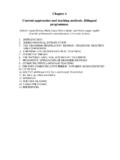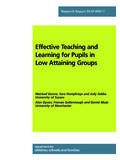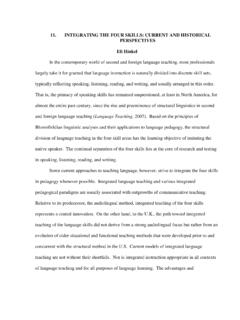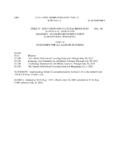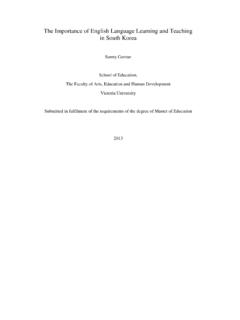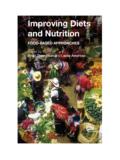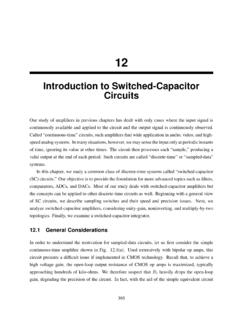Transcription of Examining the Historical Context for Teaching …
1 1 Examining the HistoricalContext for Teaching ReadingLearning GoalsAfter reading , discussing, and engaging in activities related to this chapter , you will be able the history of reading instruction to your own development as a why reading specialists and literacy coaches need to understand the influences ofmethods and approaches to Teaching reading that have been used in the United History of reading in the United StatesPrior to the20th CenturyThe Influence ofthe Church,Religion, andMoralityThe Influence ofIndustrialization,Technologies,and CulturesLiteraciesDeveloped withinand acrossMultiple ContextsNCLB, RtI, EarlyChildhood Initiatives,Secondary Focus,Mandates, andIncreased DiversityThe 1st Half ofthe 20th CenturyThe 2nd Half ofthe 20th CenturyThe Influence of the Past, Present, and Future toInform Evidence-Based Programs, Practices,and Decision MakingThe 21st CenturyFIGURE Overview2 Part I reading Specialists and Literacy Coaches: Honoring the Past, Shaping the and describe Historical terminology, methods, and materials used for teachingreading in the United what is meant by evidence-based practice and programs and describe how readingspecialists and literacy coaches can foster such Learning Goal.
2 In a three-minute brainstorming session, share what you knowabout the history of reading instruction. Write a goal or a question that reflects somethingyou want to learn about this topic. Share this with others in your for reading ProfessionalsThis chapter provides focused support for current IRA Standards for reading our companion website for a complete listing of the standards that align with this Johnson has recently been hired as herdistrict s reading coordinator. She is responsiblefor overseeing the literacy instructional programsin the twenty-four elementary and middle schoolsin the district. For the past five years, she hasserved as her school s reading specialist.
3 Hersupervisor, the assistant superintendent for cur-riculum and instruction, has expressed concernabout the district s lack of a cohesive reading pro-gram for the elementary grades, and he has beenpushing Barbara to get teachers on the samepage for reading . The community has experienced a gradualincrease in the number of English language learn-ers over the past ten years, as well as a number ofnew teachers. District standardized test scoreshave dipped in comparison to comparable dis-tricts in the state, and teachers, administrators,parents, and the school board have all expressedconcern about achieving adequate yearly are currently several integrated read-ing series in use in the elementary grades, as wellas supplemental programs for Teaching phonicsand spelling.
4 Although teachers use a Readers/Writers Workshop approach, there is little agree-ment about its structure. Some upper-gradeteachers have chosen to use class sets of chapterbooks for their reading instruction rather thanany commercial reading do you suspect are the underlying issues Barbara may want to investigate? issue should she address first?Expanding the Vignette: Exploring the IssuesBarbara decided that her first step was to meetwith teachers and reading specialists at each ofthe twenty-four schools. Almost immediately shebecame aware of the strong prejudices someteachers held in favor of the reading approachesthey were currently using.
5 She frequently heardcomments from veteran teachers, such as: I vebeen doing this for years, and my students allbecame readers. Why should I think about chang-ing how I teach? Look, reading programs andapproaches come and go, and we just jump onany bandwagon that comes along. Yes, I teachChapter 1 Examining the Historical Context for Teaching Reading3 Thinking additional issues and questions have you identified in the vignette? are some short-term suggestions you would give Barbara? long-term measures should Barbara consider, given the district policies and theteachers with whom she is working?
6 Are some proactive measures a reading specialist or coach, either at the schoolor district level, could take to avoid the problems you identified?Keep your answers to these questions in mind as you read. We will revisit the vignetteat the end of this Barbara is experiencing is not uncommon. She works in a district in which thereading program is loosely defined. Consequently, teachers are all doing what they believeworks best, based on their experience, resources, and student population. As an experi-enced reading specialist and teacher, she, too, has used a number of innovative approaches,materials, and trends.
7 However, she has also seen these same approaches and materials fallinto disfavor and disappear when the new tidal wave of methods and instructional resourceshits. How can Barbara lead the teachers toward an investigation of practices that are evi-dence based?Why Change?We find it amazing that between the two of us, we have over seventy years of Teaching expe-rience, and during this time, we ve survived a variety of trends and approaches. Through-out, we ve adjusted our instruction, learned new methods, and adapted to the latest. Although we old-timers like to say kids don t change, the reality is that they dochange.
8 Society changes, the school population changes, parents change, teachers change,and reading curriculum changes. It s part of the teacher s life and the more reading spe-cialists understand the change process, including what s come before, the better able we areto make sound instructional decisions about what children and adolescents need to becomeproficient readers and writers in a complex this chapter we provide an Historical synopsis of some of the approaches and meth-ods that have been used for Teaching reading during the twentieth century and into thephonics, and, yes, I teach comprehension. I vebeen through all the phases and I ve seen all thetrends.
9 What I ve learned is that what I use toteach reading isn t nearly as important as how Iteach it. However, several new teachers expressedconcerns, such as: I m just trying to figure outwhat I m doing. At the university, my professorssaid I should be Teaching in a particular way, butI don t see the teachers at my school doing that. I don t know what to do or what I should use. Ijust want to survive this school year. Barbara felt overwhelmed after discussingthese issues with the teachers and reading spe-cialists throughout her district. They seemed sur-prised when asked if there was a research basefor why they taught as they did.
10 She knew theassistant superintendent was expecting a plan ofaction, and she knew he wanted it , she didn t know where to We attempt to situate them in the political, cultural, social, and Historical con-texts that shaped them. Think about how you learned to read. If you and your parents shareyour memories, you will most likely discover that their memories of learning to read aredifferent from yours. If you are a seasoned teacher and have taught for twenty to thirtyyears, you have probably gone through at least three major cycles in reading instructionalapproaches and materials. In the following section, we ll explore some of these and howtheory, research, political, and sociocultural factors have influenced the methods, approaches,and materials used in schools.










